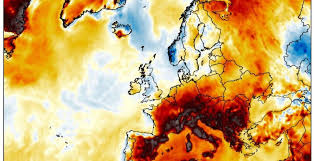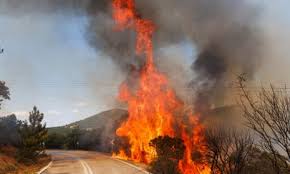
Driving in hazardous hot weather in Greece requires to Prepare Your Vehicle. Check Cooling System & Radiator – Ensure coolant levels are adequate to prevent overheating. The most of the cars re equipped with very good water engine liquid, it is difficult to fail.
Inspect Tires – Hot asphalt can increase tire pressure; check for proper inflation and tread wear to avoid blowouts. The tyres of the rental cars in Greece are made for summer temperatures.
Test Air Conditioning – Make sure it works efficiently to keep the cabin cool. The system works better when you use scale 1 or Scale 2. The compressor of the rental car airco system can easier cool the air by this, most tourists turn fan to scale 4 or 5 that results the compressor not to cool the air promptly!!
Carry Extra Water – For both the engine (in case of overheating) and passengers carry water, you never know if this will be needed and for what reason.
An Emergency Kit – Include sunglasses, sunscreen, a hat, a first-aid kit, and a power bank device, you never know if the car breaks down after an accident. Most rental cars are in excellent working condition, if you crash into an object then you may need to wait until the replacement car arrives.
 Driving in hazardous hot weather in Greece requires to Plan Your Trip Wisely. Avoid Peak Heat (12 PM – 5 PM) – Drive early in the morning or late in the evening when temperatures are lower. Check Weather & Fire Alerts – Greece sometimes experiences wildfires; avoid areas with active fires or extreme heat warnings. Know Your Route – Some rural roads may lack shade or emergency services.
Driving in hazardous hot weather in Greece requires to Plan Your Trip Wisely. Avoid Peak Heat (12 PM – 5 PM) – Drive early in the morning or late in the evening when temperatures are lower. Check Weather & Fire Alerts – Greece sometimes experiences wildfires; avoid areas with active fires or extreme heat warnings. Know Your Route – Some rural roads may lack shade or emergency services.
 Driving in hazardous hot weather in Greece requires to Stay Hydrated & Cool. Drink Plenty of Water – Avoid dehydration, which can cause fatigue and dizziness. Use Sun Protection – Wear light clothing, sunglasses, and apply sunscreen. Take Breaks – If feeling overheated, stop in shaded or air-conditioned areas.
Driving in hazardous hot weather in Greece requires to Stay Hydrated & Cool. Drink Plenty of Water – Avoid dehydration, which can cause fatigue and dizziness. Use Sun Protection – Wear light clothing, sunglasses, and apply sunscreen. Take Breaks – If feeling overheated, stop in shaded or air-conditioned areas.
Driving in hazardous hot weather in Greece requires to Drive Cautiously. Watch for Heat Hazards ,Tarmac melting can make roads slippery, especially in mountainous areas. Sudden dust storms or wildfires may reduce visibility. Avoid Overworking the Engine – Shift to lower gears on steep hills to prevent overheating. Keep a Safe Distance – Hot weather can increase brake wear and reduce stopping efficiency.
Driving in hazardous hot weather in Greece requires to In Case of Breakdown or Emergency. Pull Over Safely – If the car overheats, turn off the AC, turn on the heater (to draw heat from the engine), and stop in a shaded area. Call for Help – Greece’s emergency number is 112. For roadside assistance, contact your rental company or insurance provider. Never Leave Children or Pets in the Car – Even for a few minutes, temperatures can become deadly.
Driving in hazardous hot weather in Greece requires to Be Aware of Wildfire Risks. If you see smoke or fire, do not drive toward it, strong wind can change direction rapidly. Follow local authorities' instructions (evacuation routes may be activated). The wind in an open area and especially in an island like Crete can be 130km per hour or 12 bofor scale!!

By following these precautions, you can minimize risks and enjoy safer travel in Greece’s hot summer conditions. Stay alert and prioritize safety!
 Driving in hazardous hot weather in Greece requires to Plan Your Trip Wisely. Avoid Peak Heat (12 PM – 5 PM) – Drive early in the morning or late in the evening when temperatures are lower. Check Weather & Fire Alerts – Greece sometimes experiences wildfires; avoid areas with active fires or extreme heat warnings. Know Your Route – Some rural roads may lack shade or emergency services.
Driving in hazardous hot weather in Greece requires to Plan Your Trip Wisely. Avoid Peak Heat (12 PM – 5 PM) – Drive early in the morning or late in the evening when temperatures are lower. Check Weather & Fire Alerts – Greece sometimes experiences wildfires; avoid areas with active fires or extreme heat warnings. Know Your Route – Some rural roads may lack shade or emergency services. Driving in hazardous hot weather in Greece requires to Stay Hydrated & Cool. Drink Plenty of Water – Avoid dehydration, which can cause fatigue and dizziness. Use Sun Protection – Wear light clothing, sunglasses, and apply sunscreen. Take Breaks – If feeling overheated, stop in shaded or air-conditioned areas.
Driving in hazardous hot weather in Greece requires to Stay Hydrated & Cool. Drink Plenty of Water – Avoid dehydration, which can cause fatigue and dizziness. Use Sun Protection – Wear light clothing, sunglasses, and apply sunscreen. Take Breaks – If feeling overheated, stop in shaded or air-conditioned areas.